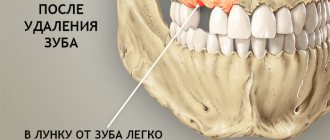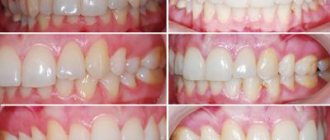According to antiplagiat.ru, the uniqueness of the text as of October 16, 2018 is 90.3%.
Key words, tags: tooth extraction, wisdom tooth, bone tissue, implant installation, augmentation, implantation.
Despite the rapid development of modern dentistry, tooth extraction is still a very common operation. When a doctor removes a tooth, be it a dystopic wisdom tooth or a severely rotted molar, in its place there remains a hole, a cavity, which is called the alveolar socket. Previously, the affected tooth was simply removed, and the resulting cavity, the socket, healed on its own, with a significant decrease in bone tissue. But today, when talking about qualified dental care, we should talk about preserving the alveoli in its original state, even in the absence of a tooth.
Anatomy of the alveolar process
The alveolar, or dental, process (from Latin - processus alveolaris) is the part of the upper and lower jaws that extends from their bodies and contains teeth. The development and normal functioning of this structure is ensured by the roots of the teeth located in it. The alveolar process appears only after teeth erupt and almost completely disappears with their loss. After a tooth is removed, the corresponding area undergoes resorption (resorption). Dental alveoli, or sockets, are individual cells of the alveolar process in which teeth are located. They are separated from each other by bony interdental (interalveolar) partitions. Inside the alveoli of multi-rooted teeth there are also internal (intra-alveolar) interradicular septa, which extend from the bottom of the alveoli and divide the alveoli into chambers (according to the number of roots). The alveolar socket of the tooth has clear, defined boundaries, and it has all the conditions for bone regeneration; you just need to help it maintain its contour.
Hole preservation procedure
Preservation of the socket of an extracted tooth is a fairly simple and effective operation for preserving bone volume and maximizing the preservation of the natural contours of the alveolar socket. This surgical procedure is performed under local anesthesia and does not pose any risk.
Usually the operation is carried out in several stages:
- treatment of the hole after tooth extraction with special antiseptic compounds;
- installation of a membrane to protect the vestibular wall;
- filling the socket cavity with granular bone-forming substance;
- fixation of the operating surface by tensioning the free edges of the connective tissue;
- applying a bandage or a thin, neat suture.
Complete healing of the postoperative area occurs by the fourth week, and after 3–4 months, in some cases 6 months, if the condition is satisfactory, this area can be used to install an implant.
Treatment quality criteria
The main criterion for the quality of an alveolar socket preservation operation is its independent complete healing and maximum preservation of bone tissue, preservation of the natural contour and volume of the alveolar ridge, improvement of the condition of soft tissues and simplification of further stages of treatment. If the operation is successful, there will be enough bone tissue in the socket to install a dental implant. Separately, it is worth highlighting the advantages of condomization for the doctor and the patient - this is improved long-term treatment results, more predictable aesthetics and, of course, saving time for the doctor and the patient.
Our doctors
Clinic director, implant surgeon, orthopedist
Berezin Pavel Nikolaevich
Chief physician, therapist, periodontist
Sakhnova Galina Leonidovna
all Doctors
Indications for condom
Preservation of the socket of an extracted tooth is indicated for everyone who in the future wants to install a dental implant in its place. The process of loss and resorption of the jaw bone at the site of the extracted tooth begins immediately after the operation. In the first year, bone tissue resorption will be 25% in volume, and over the next 3 years the loss in width will be 40 - 60%. In the case of socket preservation after tooth extraction, a larger volume of bone tissue in the jaw and the most natural contours of the alveolar process are preserved. And then, subsequently, the likelihood of such a complex operation as alveolar bone augmentation when installing an implant will most likely not be required.
Bone atrophy after tooth extraction: causes
Dental bone is a connective tissue formed by special cells (osteocytes and osteoclasts), as well as intercellular substance. The structure of the bone and its ability to perform the necessary protective and supporting functions depend on how well the proportions between tissue elements are maintained.
- Osteocytes (osteoblasts) are responsible for the production of collagen, calcium and phosphorus salts, and general mineralization. The cells form bone, stimulate its growth and maintain volume stability.
- Osteoclasts destroy damaged or worn-out cells, making room for new tissue.
As a person ages, regenerative abilities decrease, and the influence of osteoclasts on the formation of jaw structures increases. In case of injury, tooth loss or extraction, the socket cavity is not completely filled with new material, and in the absence of the necessary loads, serious atrophy begins.
Why does tooth extraction cause rapid bone loss?
Everything in the human body is balanced. As long as an organ or part of the body functions normally, the tissues receive the necessary nutrition and energy. If systems become unusable, support will be automatically cancelled.
The fact that the jaw bone tissue is working in the correct mode is “informed” by the dental roots. They accept and redistribute the chewing load, confirming functionality. When a tooth is removed, the load on the jaw area disappears. And quite quickly the blood vessels responsible for feeding the bone atrophy, and the bone itself sharply decreases in size.
To prevent this, dentists recommend restoring the integrity of the dentition as quickly as possible - implantation or prosthetics after removal.
Contraindications
Preservation surgery is subject to the same restrictions as any osteoplastic surgery. Separately, I would like to note that it is not recommended to preserve a hole after tooth extraction in a state of acute pain, since the risk of complications increases. But in each specific clinical case, the actions of a professional dentist are strictly individual. Sometimes situations arise when you have to take risks, but this is due solely to medical indications. In any case, it is necessary to understand that performing a tooth extraction operation and subsequent preservation on a planned basis is better than as part of emergency care.
Restrictions
It is logical to perform a preservation operation after the removal of permanent molars, within the so-called sevens, second molars (except for wisdom teeth, eights), since when baby teeth fall out, bone tissue does not resorption. There is no upper age limit for performing an operation aimed at preserving the natural contours of the alveolar process.
How to relieve pain and inflammation?
The body experiences stress during surgery, so it is recommended to take a couple of days off to rest. Active pastime and stress are strictly prohibited.
To muffle the pain and relieve swelling, you should periodically apply a cold compress to the cheek for 15-20 minutes. The main thing is not to overdo it with cold, so as not to provoke inflammation.
In case of severe pain, it is necessary to take an anesthetic. If the pain intensifies on the second day, and the drug used does not have the desired effect, you need to contact the clinic.
Price
According to the classifier of surgical interventions in the oral cavity, condomation is not among the standard surgical interventions and this, of course, affects the cost of its implementation. In addition, the price of osteoplastic materials and related products is quite high. Some materials are used only in conjunction with a special membrane to avoid ingrowth of soft tissue into the alveolar socket. The price is also affected by the method of tooth extraction. Removal of a tooth or tooth root is sometimes still a traumatic procedure, leading to direct loss of alveolar bone and soft tissue. With atraumatic removal, the alveolar bone is preserved in a larger volume, which reduces the final cost of the operation.
Preservation of the socket after tooth extraction is an important procedure when planning the installation of an implant. Timely preservation of the socket will allow you to preserve such valuable bone tissue and avoid a much more complex and expensive operation to build it up - augmentation, as well as significantly reduce the overall treatment time. The cost of preserving the natural contours of the alveolar socket pays off, because you thereby provide the teeth surrounding it with a reliable position, and as a result, during implantation, you get an imitation of the removed tooth root. This procedure applies even to those patients who do not intend to restore or replace a lost tooth with an implant, because in this case the gingival contour will have the most aesthetic appearance, without failures, and will allow for the most aesthetic bridge prosthetics. Therefore, reservation is gaining increasing popularity in dental dentistry.
According to antiplagiat.ru, the uniqueness of the text as of October 16, 2018 is 90.3%.
Key words, tags: tooth extraction, wisdom tooth, bone tissue, implant installation, augmentation, implantation.
*Images: Astra Tech Dentsply Implants; Principles of hard tessue regeneration and implant therapy.
Policy regarding the processing of personal data
Purpose of processing personal data:
- Medical preventive purposes, establishing a medical diagnosis, providing medical services;
- Realization by citizens of the Russian Federation of the rights assigned to them by the Constitution of the Russian Federation to apply to medical organizations in the prescribed manner;
- Ensuring laws and other forms of regulations in relation to employees of the Center, assisting employees in training and career advancement, ensuring personal safety of employees, observing basic state guarantees for remuneration of employees, controlling the quantity and quality of work performed.
Categories of subjects whose personal data is processed in the institution:
- Persons who contact the Company for the provision of medical services.
Categories of processed personal data of this category of subjects:- Full Name,
Date of Birth,
- floor,
- address,
- telephone,
- E-mail address,
- place of work,
- passport details,
- TIN,
- x-rays,
- photos,
- necessary for planning and implementation of treatment (prosthetics).
- Employees of the Company (within the framework of labor relations).
Categories of processed personal data of this category of subjects:- taxpayer identification number (TIN);
number of the state pension insurance certificate;
- foreign languages;
- work experience;
- family composition;
- passport details;
- address;
- information on military registration;
- employment contract;
- appointments;
- professional certification;
- training;
- professional retraining;
- state and departmental awards, honorary titles;
- information about holidays;
- business trips;
- sick leave;
- labor activity before being hired at the clinic;
- date and reason for retirement;
- available certificates;
- having a criminal record;
- presence of a foreign passport;
- trips abroad;
- wage;
- bank account number;
- photos.
- The Company's counterparties (within the framework of concluded agreements).
Categories of processed personal data of this category of subjects:- taxpayer identification number (TIN);
Full Name;
- residence address;
- email address;
- contact number;
- Bank details.
Legal basis for the processing of personal data: Federal Law of July 27, 2006 No. 152FZ "On Personal Data"; Federal Law of July 24, 1998 No. 125FZ "On Compulsory Social Insurance against Industrial Accidents and Occupational Diseases"; Federal Law dated November 21, 2011 N 323FZ “On the fundamentals of protecting the health of citizens in the Russian Federation”; consent of employees to the processing of personal data; concluded agreements with contractors.
List of actions with personal data
Collection, recording, systematization, accumulation, storage, clarification (updating, changing), extraction, use, transfer (provision, access) within the framework of a tripartite agreement, at the request of the court, on the basis of regulatory documents, depersonalization, blocking, deletion, destruction.
The processing of the above personal data is carried out with and without the use of automation tools.
Information on ensuring the security of personal data in accordance with the requirements for the protection of personal data established by the Government of the Russian Federation:
- Legal and organizational measures for the security of personal data: the Company has developed organizational and administrative documents regulating the process of receiving, processing, storing, transferring and protecting personal data.
- Technical measures to ensure the security of personal data during processing carried out using automation tools:
- blocking unauthorized access to personal data (setting access passwords on PCs on which personal data is processed);
- use of means of protecting personal data from unauthorized access (systems for differentiating access rights to information, cryptographic protection, use of information archiving programs using the encryption method and encoding of transmitted data on a PC processing personal data; web interface with installed certificates and user authentication);
- preventing the introduction of malicious programs (virus programs) and software bookmarks into information systems (Microsoft Security anti-virus package).
When processing is carried out without the use of automation tools:
- separation of personal data from other information by recording them on separate tangible media;
- determining the procedure for storing physical media of personal data and establishing a list of persons processing personal data or having access to it;
- restricting user access to premises where storage media are stored;
- placement of storage media containing personal data within the controlled area;
- ensuring separate storage of tangible media of personal data, the processing of which is carried out for various purposes;
- compliance with conditions that ensure the safety of personal data and exclude unauthorized access to them: storage of documents containing personal data in specially equipped rooms, safes, metal cabinets, installation of bars on windows, fire alarm systems;
- conducting an internal audit of the security of the institution’s personal data information systems;
- Conducting introductory and ongoing briefings for employees of the institution authorized to process personal data.
The right of the subject of personal data to access his personal data
- The subject of personal data has the right to receive the following information:
- confirmation of the fact of processing of personal data by the operator;
- legal grounds and purposes of processing personal data;
- the purposes and methods of processing personal data used by the operator;
- name and location of the operator, information about persons (except for the operator’s employees) who have access to personal data or to whom personal data may be disclosed on the basis of an agreement with the operator or on the basis of federal law;
- processed personal data related to the relevant subject of personal data, the source of their receipt, unless a different procedure for the presentation of such data is provided for by federal law;
- terms of processing of personal data, including periods of their storage;
- the procedure for the exercise by the subject of personal data of the rights provided for by this Federal Law;
- name or surname, first name, patronymic and address of the person processing personal data on behalf of the operator, if the processing has been or will be assigned to such a person;
- other information provided for by this Federal Law or other federal laws.
- The information specified in paragraph 1 must be provided to the subject of personal data by the operator in an accessible form, and it should not contain personal data relating to other subjects of personal data, unless there are legal grounds for the disclosure of such personal data.
- The information specified in paragraph 1 is provided to the subject of personal data or his representative by the operator upon application or upon receipt of a request from the subject of personal data or his representative.
The request must contain the number of the main document identifying the subject of personal data or his representative, information about the date of issue of the specified document and the issuing authority, information confirming the participation of the subject of personal data in relations with the operator (contract number, date of conclusion of the contract, conventional verbal designation and (or) other information), or information otherwise confirming the fact of processing of personal data by the operator, the signature of the subject of personal data or his representative. The request can be sent in the form of an electronic document and signed with an electronic signature in accordance with the legislation of the Russian Federation. - If the information, as well as the processed personal data, was provided for familiarization to the subject of personal data at his request, the subject of personal data has the right to contact the operator again or send him a repeated request in order to obtain information and familiarize himself with such personal data no earlier than thirty years later. days after the initial application or sending of the initial request, unless a shorter period is established by federal law, a regulatory legal act adopted in accordance with it, or an agreement to which the subject of personal data is a party or beneficiary or guarantor.
- The subject of personal data has the right to contact the operator again or send him a repeated request in order to obtain the information specified in clause 1, as well as in order to familiarize himself with the processed personal data before the expiration of 30 days, if such information and (or) the processed personal data were not provided to him for review in full based on the results of consideration of the initial appeal. A repeated request must contain a justification for sending a repeated request.
- The operator has the right to refuse the subject of personal data to fulfill a repeated request that does not meet the conditions provided for in clauses 4 and 5. Such a refusal must be motivated. The obligation to provide evidence of the validity of the refusal to fulfill a repeated request lies with the operator.
- The right of a personal data subject to access his personal data may be limited in accordance with federal laws, including if:
- the processing of personal data, including personal data obtained as a result of operational search, counterintelligence and intelligence activities, is carried out for the purposes of national defense, state security and law enforcement;
- the processing of personal data is carried out by authorities that detained the subject of personal data on suspicion of committing a crime, or brought charges against the subject of personal data in a criminal case, or applied a preventive measure to the subject of personal data before filing charges, with the exception of cases provided for by the criminal procedure legislation of the Russian Federation, if permitted familiarizing the suspect or accused with such personal data;
- processing of personal data is carried out in accordance with the legislation on combating the legalization (laundering) of proceeds from crime and the financing of terrorism;
- access of the personal data subject to his personal data violates the rights and legitimate interests of third parties;
- the processing of personal data is carried out in cases provided for by the legislation of the Russian Federation on transport security, in order to ensure the sustainable and safe functioning of the transport complex, protect the interests of the individual, society and the state in the field of the transport complex from acts of illegal interference.
The subject of personal data has the right to demand from the operator clarification of his personal data, blocking or destruction of it if the personal data is incomplete, outdated, inaccurate, illegally obtained or is not necessary for the stated purpose of processing, as well as take measures provided by law to protect his rights .
Responsible for organizing the processing of personal data at Dental Implantation Center LLC is Andrey Aleksandrovich Morzhuev.











